A guide to frying pans: non-stick or stainless steel, cleaning & care
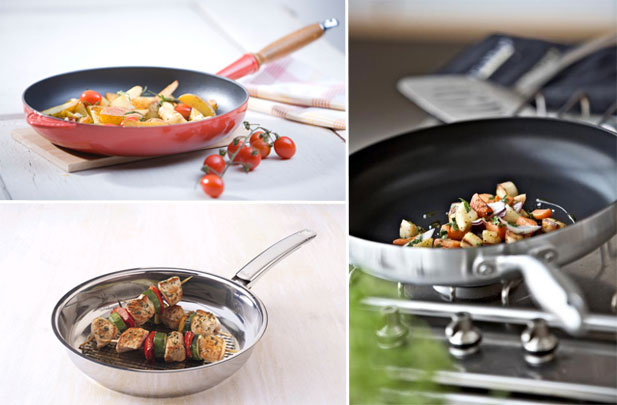 Well, it’s all up to use (and yes, you). What you plan to use the pan for should dictate the kind of pan you buy, and often it’s better to have more than one to use in different situations. To help you out when making your choice, here are a few guidelines to consider.
Well, it’s all up to use (and yes, you). What you plan to use the pan for should dictate the kind of pan you buy, and often it’s better to have more than one to use in different situations. To help you out when making your choice, here are a few guidelines to consider.
Cooking with non-stick
Non-stick pans are great. They clean up easily, make cooking a breeze, and are the pan that many of us use on a daily basis. The non-stick surface can be made from a variety of non-reactive substances, which is what makes them so good. Scanpan non-stick, for example, is made of a ceramic titanium coating, while Swiss Diamond boasts 1000s of commercial diamonds in their coating.
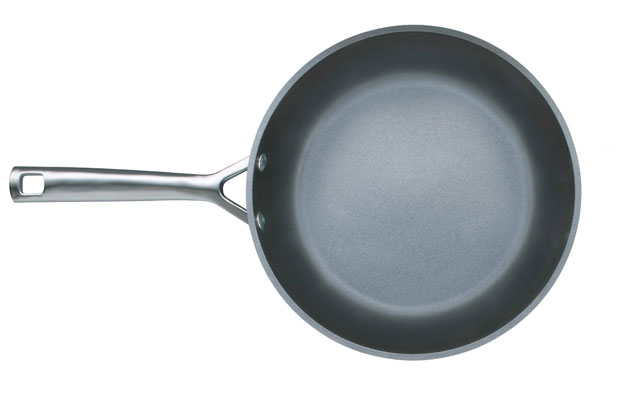 Rule of thumb is this: if what you’re cooking is likely to be sticky (like eggs), and requires a mid- to low heat, then non-stick is the perfect choice. And, as with so many things, buy the best you can afford – the coating will be better quality and will last much longer.
Rule of thumb is this: if what you’re cooking is likely to be sticky (like eggs), and requires a mid- to low heat, then non-stick is the perfect choice. And, as with so many things, buy the best you can afford – the coating will be better quality and will last much longer.
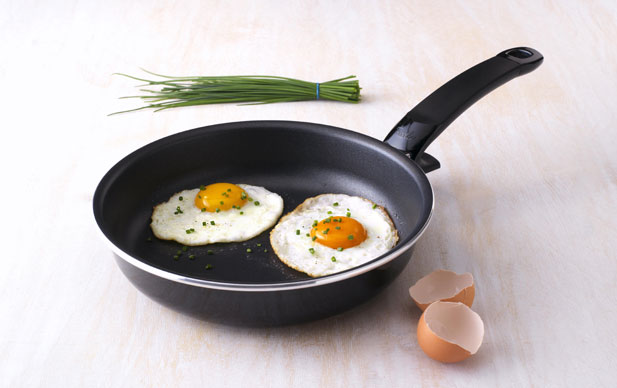 In general, non-stick reacts badly to a high heat, so to preserve the life of the coating, use on a mid- to low heat, and remember to always use plastic, nylon or wooden utensils to avoid scratching the surface. Check out our range of non-stick frying pans.
In general, non-stick reacts badly to a high heat, so to preserve the life of the coating, use on a mid- to low heat, and remember to always use plastic, nylon or wooden utensils to avoid scratching the surface. Check out our range of non-stick frying pans.
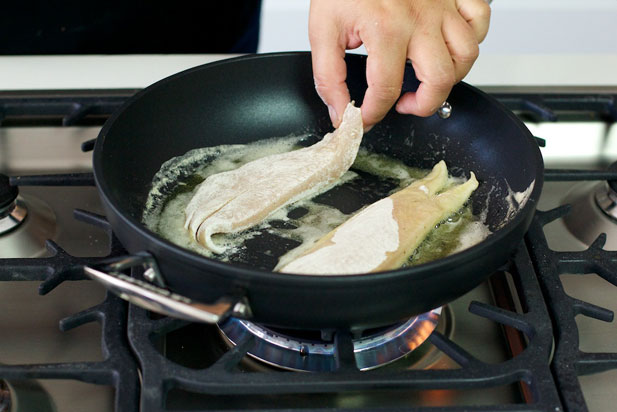 Stainless Steel warriors
Stainless Steel warriors
Many professional cooks swear by stainless steel pans – they are long-lasting and hardy, often lighter than, say, cast iron pans, and are completely non-reactive (which is great when deglazing a pan using an acidic substance like wine or lemon juice). If you’re browning meat, stir frying, or prefer metal utensils, then stainless steel is your friend. It also creates a fantastic and tasty fond with which to make a pan sauce, which is a big plus.
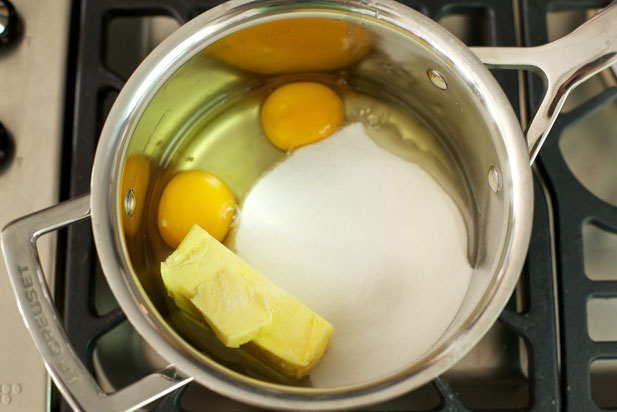 The best stainless steel pans are heavier, as they will have a core of highly conductive metal, like aluminium, sandwiched between the stainless steel. This helps to conduct heat evenly all over the pan, which helps with even cooking.
The best stainless steel pans are heavier, as they will have a core of highly conductive metal, like aluminium, sandwiched between the stainless steel. This helps to conduct heat evenly all over the pan, which helps with even cooking.
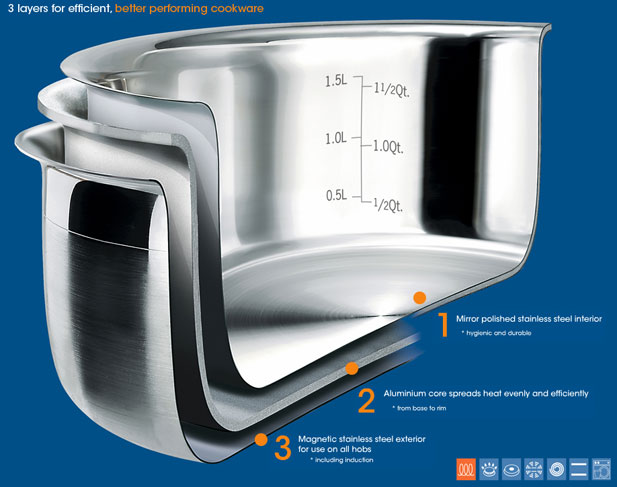 Think stainless steel is hard to keep clean? Think again. The trick with using stainless steel is to heat to a high heat, turn down, and put a drop of oil into the pan and swirl around. Leave it for a minute or so, to cool off the almost smoking point, and then add food, and a little more oil if necessary. This allows the heat and oil to close the microscopic pores in the pan, making much less prone to food sticking semi-permanently. This should be done every time the pan is used, as cooling and washing will open up those pores again.
Think stainless steel is hard to keep clean? Think again. The trick with using stainless steel is to heat to a high heat, turn down, and put a drop of oil into the pan and swirl around. Leave it for a minute or so, to cool off the almost smoking point, and then add food, and a little more oil if necessary. This allows the heat and oil to close the microscopic pores in the pan, making much less prone to food sticking semi-permanently. This should be done every time the pan is used, as cooling and washing will open up those pores again.
 Cast iron cooking
Cast iron cooking
Need a good sear? Cast iron is your man as it transfers heat very efficiently and is therefore great for cooking steaks. Cast iron is heavy, and heats evenly. It transfers heat extremely efficiently, and holds heat for longer periods. Because it is so efficient, it should also be used at a mid- to low heat, and will sear a steak beautifully – just allow time for the pan to heat first, and add food when it is hot. The cast iron doesn’t react particularly well with acids, like wine, so if you plan to deglaze, use a stainless steel pan instead. To clean after cool, scrub with a sponge and natural abrasive, like salt. Store with a light film of cooking oil to prevent rust spots from forming.
 Very important for cast iron, is that your pan is properly seasoned (or enamelled). There are many ways to season a cast iron pan – some say you should cook only bacon in a new pan for the first year, or bake it covered in fat several times before use. To season an old pan, scrub away any rust and crusted on food, and allow to dry completely. Rub with a thin layer of oil and put into a cold oven. Turn the heat to 180°C, with the pan inside. Allow to bake at 180°C for 30 minutes, and cool in the oven. When cool, wipe dry with paper towels, and the pan is ready for it’s first use.
Very important for cast iron, is that your pan is properly seasoned (or enamelled). There are many ways to season a cast iron pan – some say you should cook only bacon in a new pan for the first year, or bake it covered in fat several times before use. To season an old pan, scrub away any rust and crusted on food, and allow to dry completely. Rub with a thin layer of oil and put into a cold oven. Turn the heat to 180°C, with the pan inside. Allow to bake at 180°C for 30 minutes, and cool in the oven. When cool, wipe dry with paper towels, and the pan is ready for it’s first use.
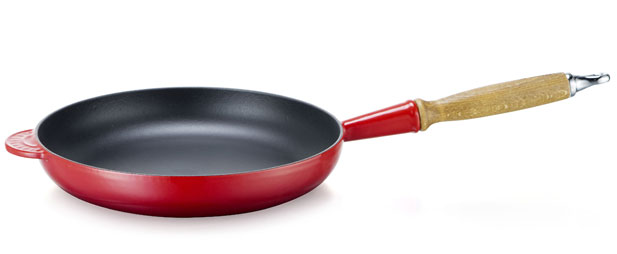 The non-stick patina will increase every time oil or a fat is heated in the pan, and will get better and better, provided the pan is not scrubbed with water. If a thorough washing is required, re-season. Seasoning like this can be done as many times as you like, and will only improve the surface of the pan. So whenever you have the oven on for something else, put the pan in at the same time. All this is, of course, not necessary for enameled cast iron cookware – just the plain cast iron.
The non-stick patina will increase every time oil or a fat is heated in the pan, and will get better and better, provided the pan is not scrubbed with water. If a thorough washing is required, re-season. Seasoning like this can be done as many times as you like, and will only improve the surface of the pan. So whenever you have the oven on for something else, put the pan in at the same time. All this is, of course, not necessary for enameled cast iron cookware – just the plain cast iron.
So as you can see, there’s a pan for every kind of cooking. The general rule states to buy the best you can afford, and care for it well. Proper care will increase the longevity of every pan, and you’ll see great things (and delicious food) over the years. Happy cooking!
